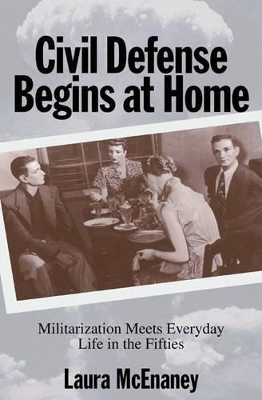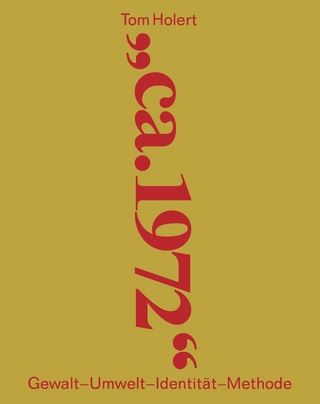
Civil Defense Begins at Home
Militarization Meets Everyday Life in the Fifties
Seiten
2000
Princeton University Press (Verlag)
978-0-691-00138-8 (ISBN)
Princeton University Press (Verlag)
978-0-691-00138-8 (ISBN)
Demonstrates that the creation of a civil defense program produced dilemmas about the degree to which civilian society should be militarized to defend itself against threats. This book uncovers responses to the militarization of daily life and reveals how government planners and ordinary people negotiated their way at the dawn of the atomic age.
Dad built a bomb shelter in the backyard, Mom stocked the survival kit in the basement, and the kids practiced ducking under their desks at school. This was family life in the new era of the A-bomb. This was civil defense. In this provocative work of social and political history, Laura McEnaney takes us into the secretive world of defense planners and the homes of ordinary citizens to explore how postwar civil defense turned the front lawn into the front line. The reliance on atomic weaponry as a centerpiece of U.S. foreign policy cast a mushroom cloud over everyday life. American citizens now had to imagine a new kind of war, one in which they were both combatants and targets. It was the Federal Civil Defense Administration's job to encourage citizens to adapt to their nuclear present and future. As McEnaney demonstrates, the creation of a civil defense program produced new dilemmas about the degree to which civilian society should be militarized to defend itself against internal and external threats. Conflicts arose about the relative responsibilities of state and citizen to fund and implement a home-front security program.
The defense establishment's resolution was to popularize and privatize military preparedness. The doctrine of "self-help" defense demanded that citizens become autonomous rather than rely on the federal government for protection. Families would reconstitute themselves as paramilitary units that could quash subversion from within and absorb attack from without. Because it solicited an unprecedented degree of popular involvement, the FCDA offers a unique opportunity to explore how average citizens, community leaders, and elected officials both participated in and resisted the creation of the national security state. Drawing on a wide variety of archival sources, McEnaney uncovers the broad range of responses to this militarization of daily life and reveals how government planners and ordinary people negotiated their way at the dawn of the atomic age. Her work sheds new light on the important postwar debate about what total military preparedness would actually mean for American society.
Dad built a bomb shelter in the backyard, Mom stocked the survival kit in the basement, and the kids practiced ducking under their desks at school. This was family life in the new era of the A-bomb. This was civil defense. In this provocative work of social and political history, Laura McEnaney takes us into the secretive world of defense planners and the homes of ordinary citizens to explore how postwar civil defense turned the front lawn into the front line. The reliance on atomic weaponry as a centerpiece of U.S. foreign policy cast a mushroom cloud over everyday life. American citizens now had to imagine a new kind of war, one in which they were both combatants and targets. It was the Federal Civil Defense Administration's job to encourage citizens to adapt to their nuclear present and future. As McEnaney demonstrates, the creation of a civil defense program produced new dilemmas about the degree to which civilian society should be militarized to defend itself against internal and external threats. Conflicts arose about the relative responsibilities of state and citizen to fund and implement a home-front security program.
The defense establishment's resolution was to popularize and privatize military preparedness. The doctrine of "self-help" defense demanded that citizens become autonomous rather than rely on the federal government for protection. Families would reconstitute themselves as paramilitary units that could quash subversion from within and absorb attack from without. Because it solicited an unprecedented degree of popular involvement, the FCDA offers a unique opportunity to explore how average citizens, community leaders, and elected officials both participated in and resisted the creation of the national security state. Drawing on a wide variety of archival sources, McEnaney uncovers the broad range of responses to this militarization of daily life and reveals how government planners and ordinary people negotiated their way at the dawn of the atomic age. Her work sheds new light on the important postwar debate about what total military preparedness would actually mean for American society.
Laura McEnaney is Assistant Professor of History at Whittier College in California.
Acknowledgments ix Introduction 3 Chapter One The Dilemmas of Planning and Propaganda 11 Chapter Two Living Underground: The Public Politics of Private Shelters 40 Chapter Three The Nuclear Family: Militarizing Domesticity, Domesticating War 68 Chapter Four Raising Women's Bomb Consciousness 88 Chapter Five "Equal in Suffering": Race, Class, and the Bomb 123 Conclusion 152 Notes 157 Bibliography 195 Index 209
| Erscheint lt. Verlag | 9.7.2000 |
|---|---|
| Reihe/Serie | Politics and Society in Modern America |
| Zusatzinfo | 9 halftones |
| Verlagsort | New Jersey |
| Sprache | englisch |
| Maße | 152 x 235 mm |
| Gewicht | 454 g |
| Themenwelt | Geschichte ► Allgemeine Geschichte ► Zeitgeschichte |
| Geisteswissenschaften ► Geschichte ► Regional- / Ländergeschichte | |
| Sozialwissenschaften ► Politik / Verwaltung | |
| ISBN-10 | 0-691-00138-3 / 0691001383 |
| ISBN-13 | 978-0-691-00138-8 / 9780691001388 |
| Zustand | Neuware |
| Haben Sie eine Frage zum Produkt? |
Mehr entdecken
aus dem Bereich
aus dem Bereich
Gewalt, Umwelt, Identität, Methode
Buch | Softcover (2024)
Spector Books OHG (Verlag)
CHF 49,95
wie Freud im Kollektiv verschwand
Buch | Hardcover (2024)
Klett-Cotta (Verlag)
CHF 34,95


